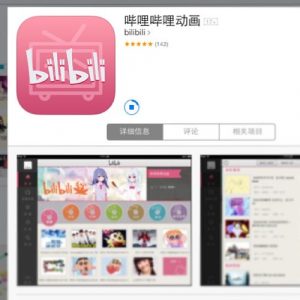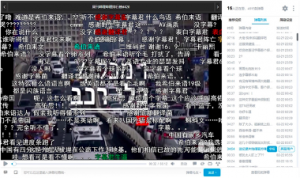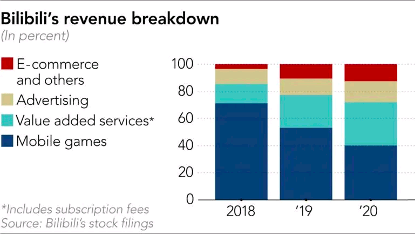In today’s era of Internet development, the significant reform brought by the Internet of Things technology provides opportunities for Bilibili’s development. Bilibili, as the leading bullet screen website in China, is different from traditional video websites. It attracts Generation Z to the Bilibili community through animation, games, culture, education, and other aspects. Therefore, this report will have an in-depth understanding of Bilibili from different aspects. Firstly, its development and business model are different from those of the same type of product. Secondly, how did Bilibili get profits from the activities? Thirdly, the role of Bilibili as a bullet screen website in different fields and whether it is successful. Finally, Bilibili company will face shortcomings in the future and the resolution plan.
Part 1 What is Bilibili?
Why is Bilibili not Chinese YouTube? Souce: Youtube – https://youtu.be/DeDFhw0C_8I
Bilibili is ostensibly a live video company that Established on June 26, 2009. Bilibili is known to the uninitiated as an anime site, but it is essentially a diversified site with high quality content (Yang, 2021). Bilibili has many content divisions, including animation, pantomime, national creation, music, dance, games, technology, life, entertainment, fashion.

Figure1. “Bilibili官方客户端终于重新上架了!感动死了~” by Wise Hou is licensed under CC BY-NC-ND 2.0
The distinguishes between Bilibili and its peers
1)Bullet screen culture
Bullet screen culture has existed in Asian media for more than a decade. A bullet screen allows viewers to overlay comments directly on top of a video, appearing as a fly-by at the top and bottom of the screen (Yang, 2021). This technology is visually striking and makes both the viewer and the video producer feel involved.

Figure 2. Screenshot of Israeli documentary without translation Made in China with danmaku, from Bilibili.com.
Since the great revolution of Internet technology, open-source connects Bilibili with media producers. Bilibili, audiences and creators play indispensable roles in media communication, production, and meaning-making (Hall, 2005). Compared to YouTube of the same type, Bilibili’s bullet screen increases the interaction between the producer and the audience. This also proves that the media information transmission has broken the traditional one direction of receiving, thus transformed into a two-side mode of information transmission. As a result, the bullet screen technique makes diversification of information dissemination.
2)Comfortable AD interstitial layout
According to Dany (2020), Bilibili advertising is mainly divided into four types: open screen advertising, information flow advertising, banner advertising, and channel advertising. While YouTube mainly uses UGC patches for advertising. Bilibili advertising typesetting features accurate user positioning. Typesetting in the middle of the content does not affect the experience of the audience. In addition, the features of YouTube are mandatory advertisement in front of videos that are watched for a few seconds before entering the main content. In contrast, Bilibili promotes the interests of the audience at the expense of advertising interests. This is the reason why draws users to the Bilibili community.
Part 2 Bilibili’s business model and profit segment
Bilibili is targeted at the Generation Z group. Hence, its business section is different from other companies. Its revenue sources mainly come from games, advertising, live streaming and value-added revenue. According to Bilibili (2021) commercial model, 71% of net revenues is from the Mobile game. Only 7% is from advertising. It aims to avoid patch advertising. This is the reason why Bilibili’s monthly active users are only a tenth less than YouTube.
In comparison, there is a considerable difference in profit (Dany, 2020). BIlibili’s game operation model is agency publishing and co-signing, collecting 50% commission (Dany, 2020). The second-largest source of revenue is value-added services, subscription fees.

Figure3. Bilibili’s revenue breakdown, from Bilibili.com
Next, Bilibili’s creators also make much money in the content section. Over the past two decades, and the Internet has brought enormous changes that have brought new cultural power and creativity to Generation Z. Today, Generation Z teenagers are consumers of Bilibili and innovators brought by technology. They dare to break through national boundaries and break down cultural prejudices for China (Yufei Mei, 2021). As a consumer and a creator simultaneously, Generation Z finds people with the same interests and hobbies in the community of Bilibili and uses great video technology and rich video content. In order to attract and influence each other. Station B provides a stage for Generation Z to show off and give material rewards. Generation Z has brought benefits to company and proved a new generation of ideas and creativity to the country.
Overall, BIlibili is seen by the public as a subculture of Generation Z. Although the ideology and culture pursued by Generation Z so far may be at odds with mainstream Chinese culture (Yin and Fung, 2017). However, Generation Z is a group of people who have grown up benefiting from Internet development. They tend to receive higher education and take the initiative in other cultures. They accept cultural exports from other countries, taking advantage of Generation Z’s creativity. The fusion of Chinese culture and other cultures produces a new cultural collision (Yufei Mei, 2021). For example, Li ziqi and other videos promoting Traditional Chinese culture break other countries’ prejudice against China on YouTube. The result has also affected a group of people in Bilibili who love Chinese culture. They are also using their manufacturing power to create a reverse export of Chinese culture. Therefore, BIlibili successfully guides the younger generation’s power to create a cultural paradise that knows no national boundaries above modern technology.
Part 3 The concern of Bilibili company in the future development
Lusoli and Turner (2021) argue that the development of digital Platforms requires bureaucratic involvement. The future development of Bilibili is also affected by the Chinese government’s censorship norms. According to de Kloet, Poell, Zeng & Chow (2019), it is necessary for the Chinese government to regulate electronic platforms that can guarantee the rights and interests of free creators. The influence of the GFW restricts access to foreign information sources and use foreign Internet tools. Moreover, Gay themes are sensitive in China, where they are illegal, so subjects’ works are banned. As a result, Chinese productions fail to have profound meaning (Feixue Mei, 2021). Therefore, it can be seen that government participation in the control can help protect the interests of creators, but it will restrict too much cultural exchange and in-depth works. In addition, as a multicultural community for the youth of the new generation, Bilibili’s strict censorship management affects the output of high-quality content. There is a bridge between the technology of the new age and the mainstream thinking of the past. The creators of era Z need to unite to create a platform for circulating Chinese culture to the world. In order to break through cultural prejudice and become the mainstream of the new community.
In conclusion,Bilibili serves as a sharing platform and gathering community for the Generation Z. In different aspects, games, animation, education and culture have been substantially improved and attracted more people. The mutual guidance between platforms and creators brings different cultural collisions for the new era. However, the bureaucratic intervention of the state also affected the depth of the work. Therefore, Bilibili should take measures to solve the problem of a government review to provide high-quality works to break the traditional prejudice against China overseas to make a qualitative change of the company.
Reference list
Bilibili. (n.d.). Retrieved October 13, 2021, from https://ir.bilibili.com/static-files/86aadb81-263c-4162-9433-285994bd0f16.
Dany, D. (2020, April 15). Why isn’t B station China’s YouTube? [Video file]. YouTube. https://youtu.be/DeDFhw0C_8I
de Kloet, J., Poell, T., Guohua, Z., & Yiu Fai, C. (2019). The platformization of Chinese Society: infrastructure, governance, and practice. Chinese Journal of Communication, 12(3), 249–256. https://doi.org/10.1080/17544750.2019.1644008
Feixue Mei. (2021). Bullet chats in China: Bilibili, language, and interaction. Transformative Works and Cultures, 36.
Hall, S. (2005). Encoding/Decoding. In Durham, M., Kellner, Douglas M. (Eds.), Media and Cultural Studies: Keyworks (pp.163 – 173). Hoboken: John Wiley and Sons.
Lusoli, A., & Turner, F. (2021). “It’s an Ongoing Bromance”: Counterculture and Cyberculture in Silicon Valley—An Interview with Fred Turner. Journal of Management Inquiry, 30(2), 235–242. https://doi.org/10.1177/1056492620941075
Yang, Y. (2020). The danmaku interface on Bilibili and the recontextualised translation practice: a semiotic technology perspective. Social Semiotics, 30(2), 254–273. https://doi.org/10.1080/10350330.2019.1630962
Yin, Y., & Fung, A. (2017). Youth Online Cultural Participation and Bilibili: An Alternative Form of Democracy in China? In Digital Media Integration for Participatory Democracy (pp. 130–154).